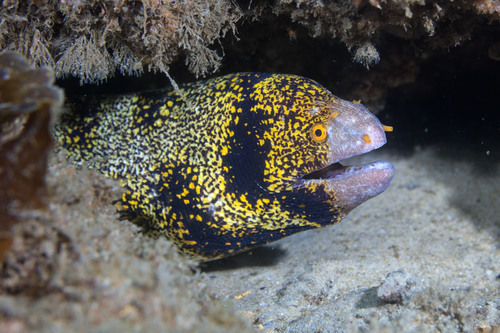
Starry Puffer
The Atlantic bluefin tuna (Thunnus thynnus) is a highly migratory, large pelagic fish renowned for its size, speed, and commercial value. It plays a crucial role in the marine ecosystem and is prized in culinary traditions worldwide.
1 4 years
Lifespan
40 - 60 cm
Length
Least Concern
Conservation Status
null km/h
Swimming speed
Carnivorous
Diet
Sedentary
Migration
Appearance Overview
The Atlantic bluefin tuna is a large, torpedo-shaped fish with a metallic blue-black back and a silvery-white belly.
Coloration
Dark metallic blue on top, silvery-white underside
Fins
Two dorsal fins, the first depressible; short pectoral fins
Body Shape
Streamlined, torpedo-shaped body built for speed
Length
Up to 13 feet (4 meters)
Weight
Up to 2,000 lbs (907 kg)
Diet
Carnivorous, feeding on fish, squid, crustaceans, and eels.
Feeding Behavior
Highly active predator, using speed and agility to hunt prey, often in coordinated groups.
Social Behavior
Forms large schools, especially during migration; highly migratory species.
Commercial Relevance
Extremely high value, especially in sushi and sashimi markets; one of the most expensive fish species.
Conservation measures
Strict fishing quotas, international agreements, and monitoring programs; some aquaculture efforts.
Status
Endangered
Threats
Overfishing, driven by high demand for sushi; bycatch in other fisheries; habitat degradation.
Habitat Distribution
Depth Range
0-1,000 meters (0-3,280 feet), often near the surface.
Geographic Range
Atlantic Ocean, Mediterranean Sea, and Black Sea.
Preferred Environment
Temperate and subtropical waters; pelagic, open ocean.
Reproduction and Life Cycle
Breeding Habits
Spawns in warm waters, primarily in the Mediterranean Sea and the Gulf of Mexico; spawning occurs in spring and summer.
Development Stages
Eggs hatch into larvae; rapid growth in the first year; juveniles develop in nursery areas before joining adult populations.
Fecundity
Females can release up to 30 million eggs per spawning season.
Maturity Age
Matures at 4-8 years, depending on the population.
Faqs about Starry Puffer
How long do Atlantic bluefin tuna live?
Atlantic bluefin tuna can live up to 40 years.
How fast can Atlantic bluefin tuna swim?
They are among the fastest fish, capable of swimming at speeds up to 43 mph (70 km/h).
Are Atlantic bluefin tuna warm-blooded?
Yes, they are warm-blooded, able to maintain a body temperature higher than the surrounding water.
What is the largest recorded Atlantic bluefin tuna?
The record is around 1,496 lbs (679 kg), caught off Nova Scotia in 1979.
Where can I find Atlantic Bluefin Tuna?
They are primarily found in the Atlantic Ocean but are highly migratory.
Why did the population decrease?
The population has decreased because of overfishing.
Copyright @ Nature Style Limited. All Rights Reserved.
 English
English